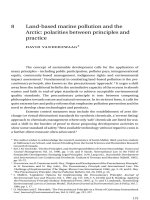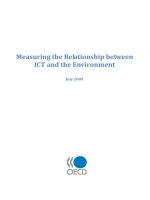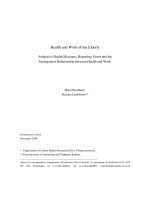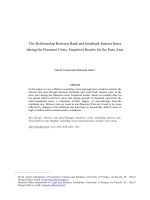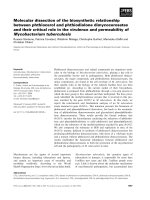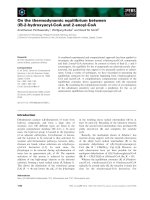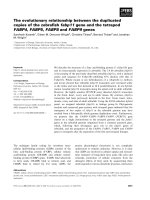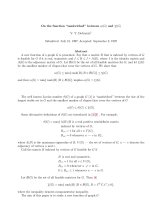Examinations on the multidimensional relationship between TQM and innovation
Bạn đang xem bản rút gọn của tài liệu. Xem và tải ngay bản đầy đủ của tài liệu tại đây (1.28 MB, 134 trang )
EXAMINATIONS ON THE MULTIDIMENSIONAL
RELATIONSHIP BETWEEN TQM AND INNOVATION
JIANG FENG
(M.Eng., TJU)
A THESIS SUBMITTED
FOR THE DEGREE OF MASTER OF ENGINEERING
DEPARTMENT OF INDUSTRIAL & SYSTEMS ENGINEERING
NATIONAL UNIVERSITY OF SINGAPORE
2004
i
Acknowledgement
I would like to take this chance to thank those people who kindly offered me helps and
supports during my study at NUS. I would like to thank my supervisor, Associate
Professor Tan Kay Chuan, for his suggestions, guidance, constant help and support
throughout this research. I also wish to thank the National University of Singapore for the
valued scholarship, which allowed me to pursue a full time master study.
I want to express my sincerest appreciation to the Department of Industrial and Systems
Engineering, which offered me this study chance and provided financial and equipment
support. I’m grateful to the lectures of ISE department and staff members, in particular,
Mr. Victor Cheo, and Ms. Ow Lai Chun. I would also like to thank all the people who
shared me their valuable experiences, ideas, suggestions and information.
It’s fortunate for me to meet many friends here, including Cheong Wee Tat, Li Dong,
Zhang Jun, Liang Zhe, Lin Shenxue, Liu Rujing, Huang Peng, Lai Xin and Xin Yan. I
would also like to show my thanks to them for all the helps and the happy time they
brought to me. I would appreciate this friendship forever.
Last but not least, I would like to thank my family and my boy friend for their
encouragement and firm supports, which gave me much confidence to face any
difficulties.
i
Table of Contents
Acknowledgement………………..……………………..………………i
Table of Contents……………………………...…….…………………..ii
Summary ...................................................................................................... vi
Nomenclature ............................................................................................. viii
List of Tables ................................................................................................ ix
List of Figures ................................................................................................x
Chapter 1. Introduction ................................................................................1
1.1 Research background .........................................................................2
1.1.1 The necessity of innovation ....................................................................... 2
1.1.2 Critiques on TQM appeared recently......................................................... 3
1.1.3 Discard TQM? ........................................................................................... 5
1.1.4 How to make TQM innovation-oriented?.................................................. 6
1.2 Research objective..............................................................................7
1.3 Thesis structure...................................................................................8
Chapter 2. Literature review......................................................................12
2.1 Innovation .........................................................................................13
2.1.1 Definition of innovation........................................................................... 13
2.1.2 Types of innovation ................................................................................. 14
2.1.3 The implementation process of innovation.............................................. 15
ii
2.2 Critical success factors of innovation...............................................19
2.3 Total quality management ................................................................22
2.3.1 The development of quality management................................................ 22
2.3.2 Principles of TQM ................................................................................... 24
2.3.3 Framework and practices of TQM........................................................... 26
2.3.4 Technical tools of TQM........................................................................... 33
2.4 The multidimensionality of TQM ....................................................33
2.5 The dichotomy of the relationship between TQM and innovation ..35
2.5.1 The mindset of customer focus and incremental improvement: good or
bad for innovation? ................................................................................ 37
2.5.2 TQM supports but also can limit organizational learning ....................... 39
2.5.3 Efficiency and flexibility ......................................................................... 40
2.6 Conclusions ......................................................................................41
Chapter 3. Research Methodology.............................................................43
3.1 Research questions ...........................................................................43
3.2 Data collection process.....................................................................49
3.3 Data analysis methods ......................................................................51
3.3.1 Structural Equation Modeling (SEM)...................................................... 51
3.3.2 Multiple group analysis of SEM .............................................................. 53
3.3.3 Analysis of Variance (ANOVA).............................................................. 54
Chapter 4. Data Analysis Results...............................................................56
iii
4.1 Validity and reliability tests .............................................................56
4.2 Test of the structural model of the general relationship between
TQM and organizational performances............................................59
4.3 Test of TQM multidimensionality....................................................61
4.4 Test of the structural model of the multidimensional relationship
between TQM and organizational performances .............................64
4.5 Model’s country-invariant test .........................................................65
4.5.1 Country-invariant test of the construct measurement model ................... 67
4.5.2 Country-invariant test of the general relationship model between TQM
and organizational performances ........................................................... 67
4.5.3 Country-invariant test of the multidimensional relationship model ........ 70
4.6 Comparisons on Practices of TQM and Organizational
Performances between Singapore and Australia ..............................71
4.6.1 Quality development in Singapore........................................................... 71
4.6.2 Comparisons on Singapore’s and Australia’s TQM practices and
organizational performances.................................................................. 72
Chapter 5. Discussions ................................................................................77
5.1 TQM positively relates to innovation...............................................77
5.2 TQM and organizational performances have a multidimensional
relationship........................................................................................78
5.3 Quality and innovation performance are correlated.........................80
iv
5.4 Leadership and process management are negatively related, while
process management and information and analysis are positively
related................................................................................................80
5.5 Practices of TQM may also show multidimensionality when
predicting organizational performance.............................................81
5.6 Further thinking on how to manipulate TQM into innovation
oriented .............................................................................................82
5.7 Implications for practice...................................................................87
Chapter 6. Conclusions and Future Research Recommendations .........89
6.1 Major findings and contribution.......................................................89
6.2 Limitations and recommendations for future research.....................93
References……………………………...…………………...……………..92
Appendix A: Survey questionnaire………………...……………..…….102
A1: Survey Questionnaire used in Singapore…………...…...…....…103
A2: Survey Questionnaire used in Australia……………………………..111
Appendix B: SQA Criteria for Business Excellence: Excellence
Indicators………………………….……………………...119
v
Summary
Summary
Both quality and innovation abilities are important to the survival and business success of
an organization. Most companies have already had a systematical quality management
system in practice, for example, ISO 9000, or other TQM programs. But till now it is not
very clear how these programs would affect organization’s innovation ability. Positive
and negative viewpoints on the role of TQM in determining innovation are both exist.
Thus this thesis is devoted to have a deeper exploration on the relationship between TQM
programs and innovation in organizational practices. A multidimensional view was
brought forwards by Prajogo and Sohal (2004) drawing on the experience of Australia
organizations. In order to validate the multidimensional view, a similar research was
carried out among Singapore organizations. A survey was performed among top 500
Singapore organizations by using the same questionnaire as that used in Australia.
There are three SEM models, the structural model of general relationship between TQM
and organizational performance, the measurement model of TQM multidimensionality,
and the structural model of multidimensional relationship between TQM and
organizational performances, to be test in this research. The three models all fitted well
with the data of Singapore as well as that of Australia. The test on the general
relationship between TQM and organizational performance, using AMOS, showed that
TQM had positive relationships with both quality performance and innovation
performance. According to the results of the model of TQM multidimensionality and the
model of multidimensional relationship between TQM and organizational performances,
vi
Summary
TQM practices took place along several dimensions. The organic dimensions, such as
leadership and people management, were related closely to innovation performance,
while the mechanistic dimensions, such as customer focus and process management,
were more related to quality performance.
Furthermore, the multiple group analysis showed that there was no country difference
between Singapore and Australia concerning the two structural relationship models. Thus
it provides another good base for the validity of the positive relationship between TQM
and innovation and the multidimensional view on the relationship between TQM and
organizational performances. The practice meaning of the multidimensional relationship
is that the organic aspects of TQM should be noticed. Organizations should pay more
attention to the organic aspects where innovation is needed. In today’s market
organizations need to be ambidextrous and make TQM both quality and innovation
oriented. TQM practices should be applied appropriately. Comparisons on TQM practices
and organizational performances between Australia and Singapore showed that there
were significant differences among these items except quality performance. The selfevaluation level was higher for Singapore organizations than Australia organizations. But
we could not conclude that the quality practices and innovation performance were better
in Singapore than in Australia. It showed a different result when comparing the answers
of some quantitative questions.
vii
Nomenclature
Nomenclature
AMOS
Analysis of Moment Structures
ANOVA
Analysis of Variance
FFE
Fuzzy Front End
FMEA
Failure Mode and Effect Analysis
GFI
Goodness-of-fit Index,
IQC
National Innovation and Quality Circles of Singapore
ISO
International Standard Organization
MBNQA
Malcolm Baldrige National Quality Award
NPD
New Product Development
QC
National Quality Circles of Singapore
QCC
Quality Control Circles
QFD
Quality Function Deployment
RMSEA
Root Mean Square Error of Approximation
SEM
Structural Equation Modeling
SIA
Singapore Innovation Award
SPRING
Standards, Productivity and Innovation Board of Singapore
SQA
Singapore Quality Award
SQC
Statistical Quality Control
SRMR
Standardized Root Mean Square Residual
TQC
Total Quality Control
TQL
Total Quality Learning
TQM
Total Quality Management
viii
List of Tables
List of Tables
Table 1.1
Critiques on TQM
Table 1.2
Thesis structure
Table 2.1
General NPD process and tasks of functions
Table 2.2
Selected historic milestones in the quality movement in the U.S
Table 2.3
Principles of ISO 9000:2000
Table 2.4
Singapore quality award criteria and weightage
Table 2.5
Summary of arguments on the relationship between TQM practices and
innovation
Table 4.1
Results of constructs validity and reliability (Singapore)
Table 4.2
Results of constructs validity and reliability (Australia)
Table 4.3
Model test results of the general relationship between TQM and innovation
Table 4.4
Model test results of TQM multidimensionality
Table 4.5
Model test results of the multidimensional relationship between TQM
practices and organizational performances
Table 4.6
Summary of group-invariant test of the measurement model for each
construct
Table 4.7
Results of group-invariance test for the general relationship between TQM
and organizational performances
Table 4.8
Results of group-invariance test for the multidimensional relationship model
Table 4.9
Group statistics for both countries’ TQM practices and organizational
performances
Table 4.10 Summary of comparisons on the latent means of TQM practices and
organizational performances
Table 4.11 Results of ANOVA test for the country differences on TQM practices and
organizational performances
Table 6.1
Summary of research findings: comparing the results of Australia data and
Singapore data
ix
List of Figures
List of Figures
Figure 1.1
Integrating TQM and radical changes
Figure 2.1
Innovation developing process
Figure 2.2
MBNQA framework
Figure 3.1
Model for the general relationship between TQM and organizational
performances
Figure 3.2
Hypothesis of multidimensional view on the relationship between TQM and
innovation
Figure 3.3
Measurement model of TQM multidimensionality
Figure 3.4
Structural model of the relationship between TQM and innovation
Figure 4.1
Final model of the general relationship between TQM and innovation
Figure 4.2
Final measurement model of TQM multidimensionality
Figure 4.3
Final model of the multidimensional relationship between TQM practices
and organizational performances
Figure 5.1
Innovation details
Figure 5.2
Impact of TQM to innovation related aspects
Figure 5.3
Multidimensional natures of TQM principles, practices and techniques
x
Chapter 1. Introduction
Chapter 1
Introduction
Total quality management (TQM), as a systematic quality management program, changes
the meaning of quality management from product quality to a new organization-wide
performance excellence. With the developing of TQM, quality management entered into
a new era. TQM not only improves the quality performance, but also builds up the culture
of the adopting organizations. In addition, TQM is a developing concept and always
keeps in line with business excellence.
Nowadays, innovation attracts more and more attention and is regarded valuable than
ever before. In order to achieve good performance, organizations need to emphasize on
innovation as well as quality. As the original concerning of TQM is quality, it would be
necessary to investigate the relationship between TQM and innovation. However, the
relationship between them is still not very clear due to the scarcity of the investigation on
this issue (Prajogo and Sohal, 2001) and the complexity of both sides. Till now, although
some studies were carried out on this issue, the results were not coincident, even opposite.
Some believed that TQM could provide support to innovation (Kanji, 1996; McAdam, et
1
Chapter 1. Introduction
al., 1998; Tang, 1998; Roffe, 1999), while others thought TQM would hinder innovation
(Hamel and Prahalad, 1994; Lynn et al., 1996; Wind and Mahajan, 1997; Slater and
Narver, 1998). There is still no comprehensive study on how TQM practices would affect
innovation. It shows the need to bridge this research gap.
Based on the experience of Australia firms, Prajogo and Sohal (2004) presented a
multidimensional view of TQM practices in determining organizations’ quality and
innovation performance. Their results showed that the organic parts, such as leadership
and people management, were related more to innovation performance, while the
mechanistic parts, such as customer focus and process management, were relatively more
significant in terms of predicting quality performance. A similar research was carried out
among Singapore organizations to cross-validate this hypothesis of the multidimensional
view.
1.1 Research background
1.1.1 The necessity of innovation
We are now in a turbulent world. The competition is rigorous and environment changes
rapidly. This phenomenon is revealed more clearly in commercial competition. Today,
companies have to compete not only on cost and quality, but also on the diversity and the
innovation speed of product. History has already told us that those who could not catch
up would be thrown out of the game. If an organization wants to keep its competitive
advantages in market, it has to build up a culture of willing to adopt changes, such as new
2
Chapter 1. Introduction
technologies and new management styles. The force of adopting changes comes from
environment, competitors and customers. Normally, new technologies and new
management theories come out frequently. Newly emerged technologies mean higher
work efficiency, lower cost and new products. They provide the possibility to open new
market areas, at the same time also terminate some old ones. Today, with the process of
globalization, competition becomes more serious than ever before, which brings both
chances and challenges. Companies need to enhance their new product development
ability and speed up the development. It is not enough to just be a quick follower. They
need to identify the chances quickly and start earlier than their competitors to stay ahead.
The tendency is to emphasize on new product development and aim at gaining more
revenues from newly developed products. In addition, due to the furious competition,
customers become more and more pernickety to the products. Companies have to provide
quality and advanced products to gain customer’s loyalty. Fostering the innovation
mindset is the only way that can continuously bring success to organizations. The
benefits involve sustainable growth engine, increased customer goodwill, enhanced
productivity, increased margins and revenues, increased employee retention, and position
in new categories (Davis and Moe, 1997).
1.1.2 Critiques on TQM appeared recently
TQM emerged with the increased demands of providing quality products. It focuses not
only on quality but also excellent organizational performances. As a result, TQM brought
a new era of quality management. It is welcomed, promoted and adopted by many
organizations. However, the road of TQM is not smooth. There are lots of critiques to
3
Chapter 1. Introduction
TQM such as those given by Harari (1993a) and Harari (1993b) and are listed in Table
1.1. In addition, large number of failures existed (Harari, 1993a). In fact, these failures
were largely due to the misunderstanding of TQM.
Table 1.1
Critiques on TQM (Adapted from Harari, 1993a; Harari, 1993b)
1 TQM focuses people's attention on internal processes rather than on external results.
2 TQM focuses on minimum standards.
3 TQM develops its own cumbersome bureaucracy.
4 TQM delegates quality to quality czars and "experts" rather than to "real" people.
5 TQM does not demand radical organizational reform.
6 TQM does not demand changes in management compensation.
7 TQM does not demand entirely new relationships with outside partners.
8 TQM appeals to faddism, egotism and quick-fixism.
9 TQM drains entrepreneurship and innovation from corporate culture.
10 TQM has no place for love.
11 In the world of business, TQM, as a formula, cannot solve management problems
To obtain best results of TQM, one must be aware of the requirement of completeness,
which means TQM must be carried out as a whole (Liu and Kleiner, 2001). TQM
shouldn’t be viewed only as a collection of certain kinds of quality insurance techniques.
It requires the commitment of the entire organization instead of only quality department.
TQM also requires organizations to make their decisions based on the long-term planning
4
Chapter 1. Introduction
instead of short-term objectives. In addition, the lack of emphasis on soft part also could
cause failure of TQM. When TQM is implemented, the culture building process is critical.
A culture of willing to adopt change and aiming at long-term development is desired. At
the mean time a learning organization, which is also important to organization’s
performance, should be formed.
Critiques towards the role of TQM in determining innovation arose when the need of
innovation increased. As Samaha (1996) said, TQM sometimes diminished the avenues
for innovation since innovation needed to leap ahead of competition. Incremental
improvement of TQM puts emphasis on small step improvements. Customers’ focus also
limits on the new product development within the minor enhance of the existing products.
The aims of quality are conformance, standardization, efficiency, and cost effective. All
these aspects are in the opposite of innovation and cause critiques.
1.1.3 Discard TQM?
There are aspects of TQM that are not consistent with innovation. Should TQM be
discarded due to that? It seems too imprudent to make this decision. Firstly, quality is to
do things in a better way, while innovation is to do things in a different way. They are
both needed for business excellence (Samaha, 1996; Sumney and Braden, 1995; Liu and
Kleiner, 2001). Secondly, TQM can be a basis for innovation. Some dimensions of TQM,
such as customer focus, training, empowerment and teamwork, benchmarking and
process management, can assist organizations to be innovative (Lorente, 1999). Thirdly,
according to some empirical research (McAdam, et al., 1998, MacAdam and Armstrong
5
Chapter 1. Introduction
2001), TQM and innovation were correlated. Companies that performed well in TQM
also tended to behave well in innovation. Finally, incremental improvement, which is
promoted by TQM, and radical improvement are not mutually exclusive (Lorente, 1999).
They should be integrated in order to maximize the competitive advantages. TQM can be
an enabler to reengineering, which is viewed as radical changes. As shown in Figure 1.1,
with the integration of incremental improvement and radical changes organizations can
double the pace of improvement. As a result, TQM should not be easily rejected. We
should study both TQM and innovation and their relationship then make these two
practices compatible.
1.1.4 How to make TQM innovation-oriented?
Now it comes to the questions of how to make TQM and innovation compatible or how
to make TQM innovation-oriented. In order to achieve this objective, the relationship
between TQM and innovation should be investigated. But the investigations on this issue
are scarce (Prajogo and Sohal, 2001) and the role of TQM in determining innovation is
still not very clear. Positive and negative views are both existed. Thus we found it is
necessary to further investigate the relationships between TQM and innovation and find
guidance for TQM practitioners to make it in line with innovation.
6
Chapter 1. Introduction
Improvement
TQM and
Radical changes
TQM
Radical changes
Time
Figure 1.1
Integrating TQM and radical changes
(Adapted from Lorente, 1999)
1.2 Research objective
The main purpose of this research is to cross-validate the multidimensional view of TQM
in determining innovation performance in organizations and to explore the relationship
between TQM and innovation further. With this research, a better understanding of the
general relationship between TQM and innovation and the impact of each TQM practice
on organization’s innovation ability as well is expected. Our research interest also falls in
the country difference between Australia and Singapore. One question is whether there is
country difference with the structural relationship models. The other is whether there are
7
Chapter 1. Introduction
differences on the TQM practices and quality and innovation performances across the
two countries.
1.3 Thesis structure
This thesis includes six chapters and can be divided into three parts as indicated in Table
1.2. The first part, formed by Chapter 1 and Chapter 2, provides an introduction and
overview of this research. The context and necessity of this research are explained in this
part. Part II is the main body of this thesis. This part is devoted to the investigation of the
relationship between TQM and innovation. It comprises Chapter 3, 4, and 5. The
investigation is explained in details, from methodology and data analysis results to
discussion. Part III, Chapter 6, has a summarization of this research. The contribution,
limitations and future research space are discussed.
This thesis begins with Chapter 1, Introduction. It explains the backgrounds and
objectives of this research. Since innovation is vital to an organization, efforts should be
put on the facilitation of it. In this part the role of TQM in innovation is discussed. Due to
the ambiguous relationship between TQM and innovation, the objective of this research
is defined to explore this relationship. The general structure of this thesis is introduced in
final section of this chapter.
8
Chapter 1. Introduction
Table 1.2
Thesis structure
Chapter 1
Introduction
Part I
Introduction and
Overview
Chapter 2
Literature Review
Chapter 3
Research Methodology
Part II
Relationship Exploration
Chapter 4
Data Analysis Results
Chapter 5
Discussions
Part III
Conclusion
Chapter 6
Conclusions and Future Research Recommendations
Chapter 2, Literature Review, provides an overview of the related topics of TQM,
innovation and their relationship. The literature review on innovation involves the
discussion of the definition of innovation, the type of innovation, the generic
implementation process of innovation, and the prerequisites of successful innovation. The
literature review of TQM begins with an overview of the development of TQM. Then the
TQM system is explained. Here TQM is explained in three levels, principles, framework
and practices, and technical tools. Followed is the literature review on the
multidimensionality of TQM. Its mechanistic and organic characteristics are both
discussed. The last part of this chapter is given to the literature review on the relationship
between TQM and innovation. It includes a review of the relationship between each
practice of TQM and innovations and the discussions on how the mindset that instituted
by TQM would affect innovation.
9
Chapter 1. Introduction
Chapter 3 provides an introduction of the research methodology. In order to make this
research more understandable, the research questions are specified. This research is based
on a survey among Singapore organizations and also the data from Australia. The data
collection process is described briefly. The questionnaire we used is originally developed
for the use in Australia. Thus a discussion on the feasibility of its use in Singapore is
provided. Finally, the major data analysis techniques, Structural Equation Modeling
(SEM) and Analysis of Variance (ANOVA), are briefly introduced.
Chapter 4 summarizes the data analysis results. Three SEM models, the structural model
of the general relationship between TQM and organizational performance, the
measurement model of TQM multidimensionality and the structural model of the
multidimensional relationship between TQM and organizational performances, were
tested. The country differences were also tested using multiple group analysis concerning
the two relationship models. Finally this chapter presents the results of the comparison on
the TQM practices and organizational performances between Singapore and Australia.
The comparison is mainly based on the self-evaluation results of each organization. The
answers of some objective questions were also analyzed. Since there was a conflict
between these two kinds of comparison, a possible explanation is provided.
Chapter 5 provides discussions on the results achieved. The positive relationship between
TQM and innovation and the multidimensional view towards the role of TQM in
determining innovation are cross-validated. Theory and empirical basis for this view is
discussed. Some related topics, such as the multidimensionality of each TQM practice
and its multidimensionality nature of each level, are explored. A discussion on how to
10
Chapter 1. Introduction
make TQM
innovation oriented is also provided. Finally the practical meaning of this
research is provided.
Chapter 6 is the final part of this thesis. It provides a summary of the research results.
This part points out the research contribution in TQM and innovation literature and also
in organizational practice. Finally, limitations of this research and the future research
recommendations are provided.
11
Chapter 2. Literature Review
Chapter 2
Literature review
In this chapter a review on the literature of innovation, TQM, and the relationship
between TQM and innovation is provided. Since this research is mainly to cross-validate
the multidimensional relationship between TQM and innovation, besides the basics of
innovation and TQM, such as definition and type, the critical factors of innovation and
the multidimensionality of TQM are also discussed in the literature review. Because in
principle this research is a replication study, the literature review of the
multidimensionality of TQM and the relationship between TQM and innovation is based
on the literature review of Prajogo and Sohal (2001, 2004). However, ours is organized
and elaborated differently.
12
Chapter 2. Literature Review
2.1 Innovation
2.1.1 Definition of innovation
Innovation can be viewed as the process of taking new ideas effectively and profitably
through to satisfy customers. It is a process of continuous renewal involving the whole
company and is an essential part of business strategy and every day practice (DTI, CBI
and National Manufacturing Council, 1993).
A definition from Damanpour (1991) for innovation is the adoption of an internally
generated or purchased device, system, policy, program, process, product, or service that
is new to the adopting organization.
McAdam and Armstrong (2001) summarized several definitions and pointed out that
innovation relates to change and creativity. They concluded that innovation was the
harnessing of creative ability within individuals and the workforce in response to change.
In order to gain the advantages of first mover, many leading companies are not only good
change followers but also good change initiators. Thus the definition of innovation
should involve both response to change and initiation of change.
In conclusion, innovation can be viewed as the change action that organizations taken. It
brings new things to the adopting organization. Creativity of the workforce is needed for
its success. Its aim is to satisfy customers and make profits.
13
Chapter 2. Literature Review
2.1.2 Types of innovation
In spite of various definitions, there are also many kinds of categories of innovation.
Some of the popularly acknowledged ones are presented in the following.
Radical and incremental
Categorized by the amount or the degree, innovation can be divided into two types:
radical and incremental. One distinction between radical and incremental innovation is
the degree of strategic and structural change that the firm must undergo to accommodate
the innovation in question (Cooper, 1998). Organizations would take great efforts and
risks to implement radical innovation, while the incremental innovation has low risks and
would be easily adopted by organizations.
Another distinction is the degree of the final result. Radical innovation emphasizes the
great effect of the innovation action. It would bring big changes and usually big amount
of profit to the company. But the incremental one emphasizes the continuous efforts to
make improvement and usually by small steps.
Process, product or service, and management
Innovation can take place in any areas of an organization. Thus generally, innovation can
be categorized into process, product or service, and management. The process innovation
is doing the same thing in a better way. The innovation of products or services is the
developing of new things. Depending on the level of newness of the new product or
14

